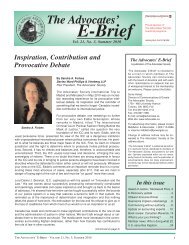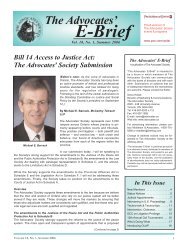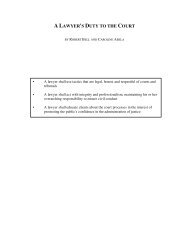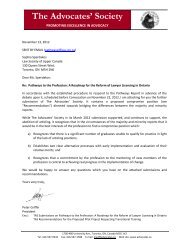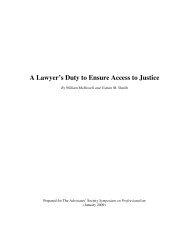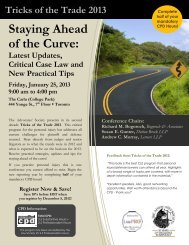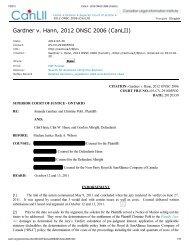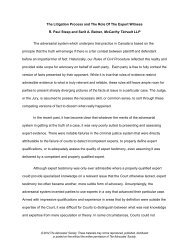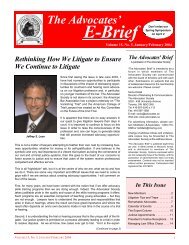Hamfler v. Mink, 2011 CanLII 86201 (ON SC) - The Advocates' Society
Hamfler v. Mink, 2011 CanLII 86201 (ON SC) - The Advocates' Society
Hamfler v. Mink, 2011 CanLII 86201 (ON SC) - The Advocates' Society
You also want an ePaper? Increase the reach of your titles
YUMPU automatically turns print PDFs into web optimized ePapers that Google loves.
1/20/13 <strong>CanLII</strong> - <strong>2011</strong> <strong>CanLII</strong> <strong>86201</strong> (<strong>ON</strong> <strong>SC</strong>)material issue?[18] <strong>The</strong>se are just some of the questions that a trial judge may ask and which I have asked myself with respect to thenecessity and reasonableness of the plaintiff’s bill of costs and in particular the list of disbursements. Fundamentallyhowever, the court must as I have done, direct itself to the question of whether the amount claimed is fair and reasonable.An expert can simply not charge what he or she considers appropriate and then expect through counsel that such fee will bedeemed acceptable by the court. Reasonableness and fairness will dictate whether a disbursement, and in this case, whetheran expert’s fee is assessable in whole or in part.DISBURSEMENT CLAIM OF MR. HAMFLER[19] <strong>The</strong> plaintiff in this matter chose to put before the court expert opinion evidence of various doctors. <strong>The</strong>se includedDr. Garber who was qualified as a clinical psychologist; Dr. Berbrayer who was qualified as a physiatrist; and Dr. Schererwho was qualified as a vocational psychologist. For reasons that perhaps are best known to the plaintiff, no evidence wascalled from any treating doctors. <strong>The</strong> plaintiff suffered a nasty facial injury as a result of what the jury clearly viewed as theunprovoked use of force against the plaintiff involving bouncers and/or security staff at the <strong>Mink</strong> Nightclub. <strong>The</strong> facial injuryrequired an operative procedure that left the plaintiff with some residual facial deformity. All in all, the plaintiff came out ofthe acute phase post incident with a good operative result. He was off work for a relatively short period of time andultimately he changed jobs.[20] In addition to the aforementioned medical doctors the plaintiff also called expert evidence from an economist-Mr.Durani; as well as a life care planner Ms. Nowitz who testified about the plaintiff’s future care needs and housekeepingneeds.[21] <strong>The</strong> plaintiff’s tax returns did not reveal any substantial change in his overall level of income but, nonetheless, theplaintiff chose to call an economist to suggest that he had suffered a very substantial past income loss and would suffer asubstantial loss of income in the future. On all accounts the jury in this case chose to almost completely reject the theory putbefore them as it related to the plaintiff’s claim for loss of income both past and future. Mr. Durani suggested the plaintiffhad suffered a past loss of income of approximately $127,000. He then presented 3 scenarios as the basis to calculate anaward for the plaintiff’s future loss of income. <strong>The</strong>se scenarios ranged from a low of $183,000 to a high of $893,000. <strong>The</strong>jury ultimately awarded the sum of $30,000 for future loss of income. It is worth reflecting on this award for future loss ofincome as it is only slightly more than one half of what the plaintiff was earning as an annual salary as of the date of trial.[22] Where a jury is told by the plaintiff’s economist that the plaintiff’s past loss of income was $127,000 and the futureloss of income could range from a low of $183,000 to a high of $893,000 and the jury then returns a verdict of $15,000 forpast loss of income and $30,000 for future loss of income, I, as the trial judge, must ask a fundamental question as to howuseful, if at all, the evidence of the economist was to the jury. This is especially so when the economist was of absolutely noassistance to the jury as to how one calculates the present value of a dollar. <strong>The</strong> jury was left completely in the dark as tohow to perform this fundamental calculation. Regrettably, I have come to the conclusion as it relates to the evidence of theMr. Durani that his evidence was of very little use to the jury.[23] As will become apparent later in my reasons, the plaintiff’s bill of costs as it relates to the legal fees claimed was forthe most part quite reasonable. <strong>The</strong> disbursements are another matter. I have already indicated that the evidence of Mr.Durani was of very little assistance to the court. <strong>The</strong> plaintiff’s bill of costs reflected a total claim for Mr. Durani of $5,460.I have allowed $2,500 for Mr. Durani’s costs to reflect the very limited assistance he was to the court and the fact hecompletely failed to give the jury the tools it would need to do a present value calculation. Such an omission is glaring andcannot be excused. It warrants a substantial reduction in the amount claimed on account of Mr. Durani’s services.[24] I then move to the disbursement list as it relates to the medical experts. As previously noted, the plaintiff chose toprove this aspect of his case through medical legal experts as opposed to treating doctors. In so doing, the plaintiff chosewhat can only be described as a Cadillac approach to the proof of the plaintiff’s damages claim. I was provided withabsolutely no assistance from the plaintiff as to how the various medical doctors arrived at the amount they charged for thecanlii.org/en/on/onsc/doc/<strong>2011</strong>/<strong>2011</strong>canlii<strong>86201</strong>/<strong>2011</strong>canlii<strong>86201</strong>.html 5/9



